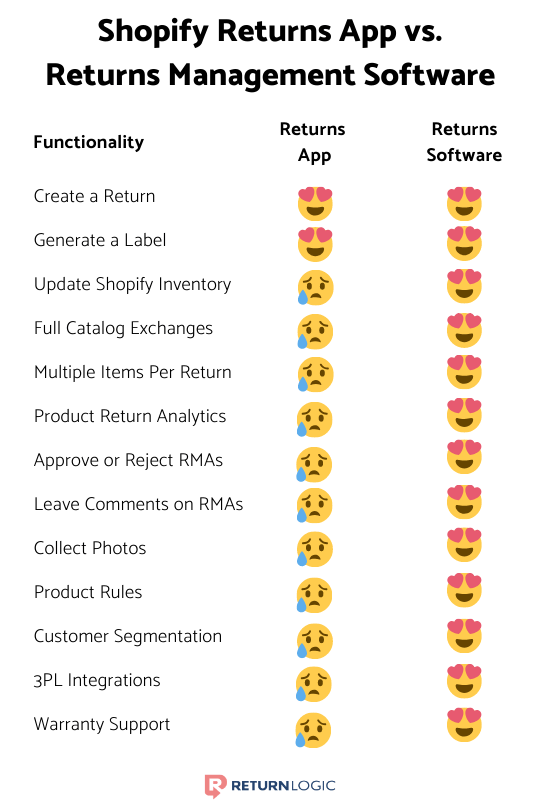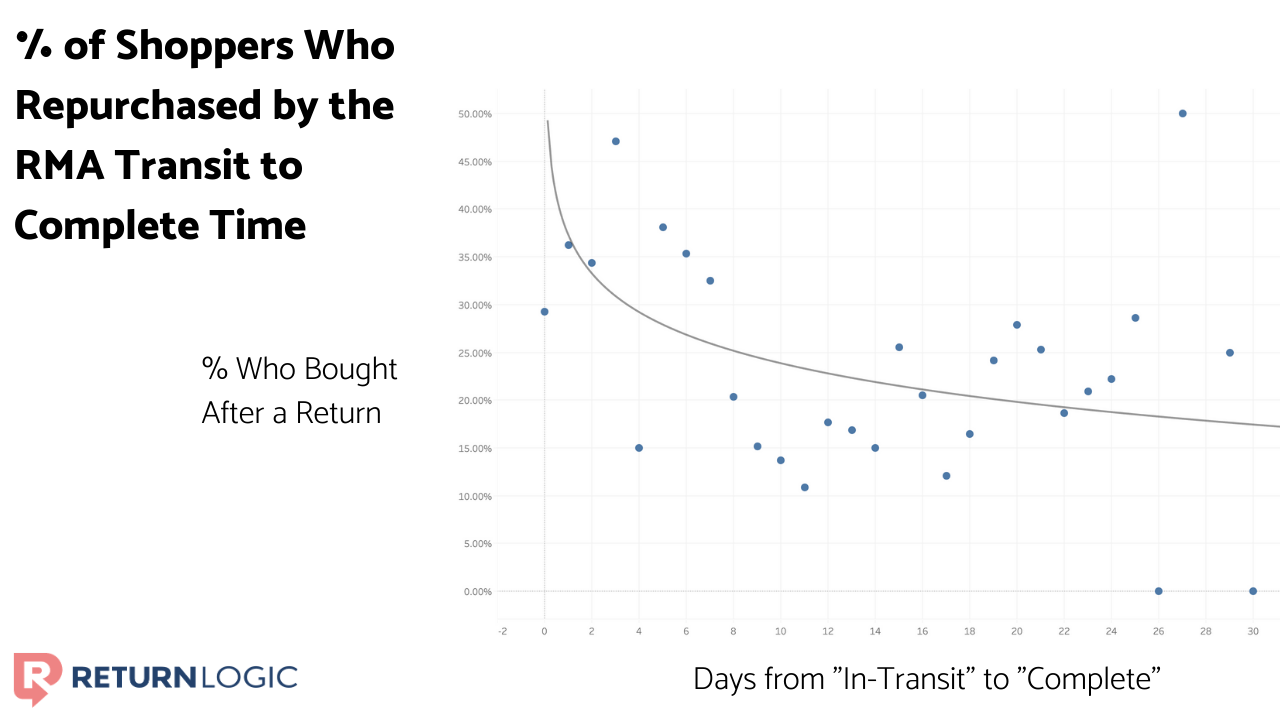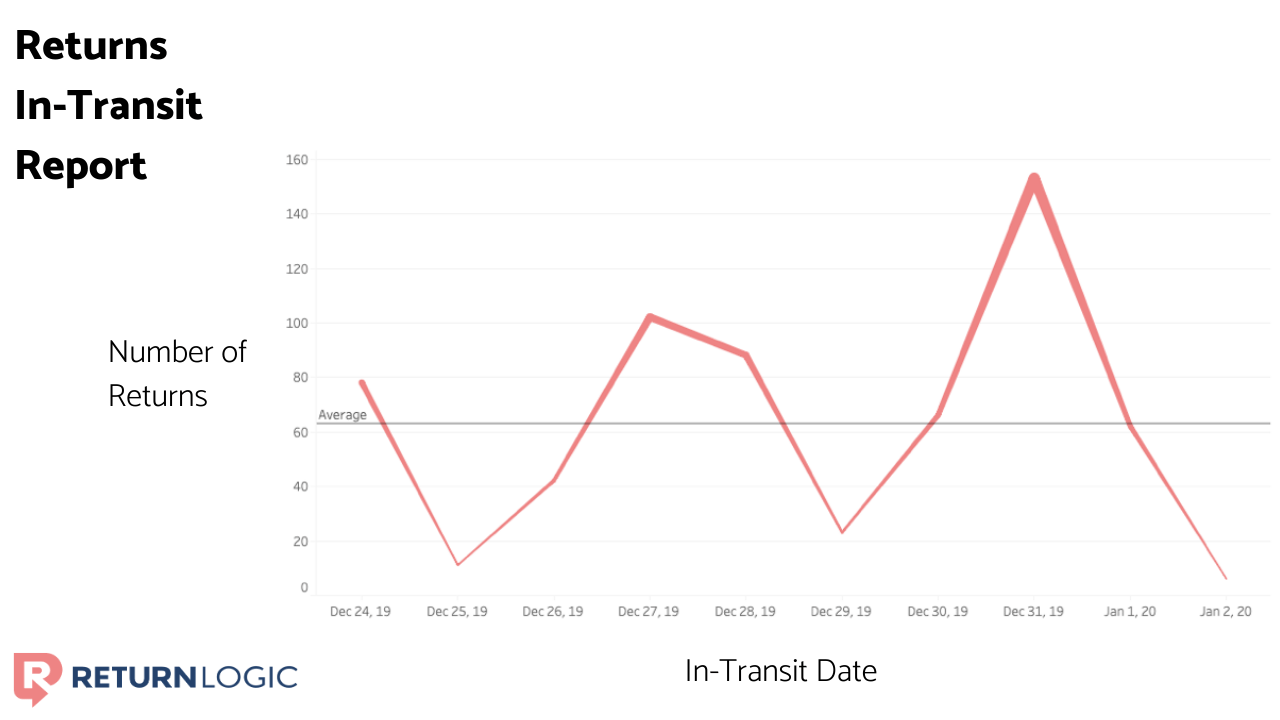Shopify Returns: Improve your Ecommerce Returns Process in 3 Simple Steps

Shopify Returns & Exchanges Done Right:
When a shopper decides to make a return or exchange from your Shopify store, they expect to find a customer friendly return policy and an easy-to-use experience to quickly complete their return.
Customers expect an easy buying experience, both on desktop and mobile. That’s why retailers of all sizes and types flock to Shopify.
But ecommerce returns are as unique as the retailer and the products they sell. That’s why most platforms don’t have built-in ecommerce returns automation.
The fact is, returns are a lot more complex than purchases. Food returns have different rules than consumer electronics. Furniture requires different handling processes than fashion and apparel returns.
And returning a watch would be very different from sending back the weed trimmer, both for the buyer and the retailer.
But retailers across all those categories experience the same vexing issue of rising average product return rates. According to the Wall Street Journal, average ecommerce return rates are hovering around 33%.
How to Manage the Shopify Returns Process
Returns are one of the most complicated problems in ecommerce. Statista estimates that returns will cost retailers over $550 billion by 2020.
This is a massively complex problem. That is why Shopify and other top ecommerce platforms don’t offer a returns management tool stack. Shopify returns documentation reflects this. It is a crude process with limited support for the enormous complexities that come with returns management.
This leaves retailers left to cobble together multiple apps, spreadsheets, and help desk tools to match returns process to their product types.
These manually-created, error-prone spreadsheets to collect returns data result in product returns processes are slow and cumbersome.
Shopify Returns Apps vs. Shopify Returns Management Software
If you’ve decided to move on from the manual returns management process, you’ll have two options: pick an app from the Shopify marketplace or sign up with a Shopify returns management software.
The biggest difference is the sophistication of the problem they solve. So it’s important for you as a retailer to be clear about what you’re trying to accomplish before selecting a solution.
Venture over to the Shopify app store and you’ll find no shortage of returns management apps. These apps are helpful for retailers who are just getting their feet wet in ecommerce. They range in price from free to $50 a month.
They provide a quick self-directed return form experience where retailers can create a return. In some cases, they also support generating a return shipping label.
Returns management software, however, seeks to solve more complex problems on both the customer experience and ecommerce operations side of the equation.

Ultimately the goal isn’t just reducing the number of returns you receive, it’s about optimizing that process for more profit.
Learn How to Evaluate Returns Management Solutions
Reducing Returns vs. Optimizing for Returns
Many Shopify retailers we speak with say that in an ideal world they would reduce the number of returns as much as possible. But in many cases, to optimize for a low number of returns is to not optimize for profit.
Optimizing your returns for profit starts with the mindset that returns are a natural and healthy part of any ecommerce business.
The more you grow, the more returns you’re going to have to manage.
Smart direct-to-consumer brands are following Amazon’s lead by optimizing their returns process for an easy customer experience, efficient backend operations, and streamlined returns data collection and analysis.
Unlocking Business Value from Shopify Returns
Many Shopify retailers have resigned themselves to believe that product returns are simply a byproduct of doing business online. The simple truth of the matter is that retailers have much more control over the returns they receive.
The faster you realize that product returns are a controllable problem, the faster they can work to optimize them.
(To help, here are 7 detailed strategies to kick start the process of reducing Shopify returns.)
With Shopify returns optimization you can transform that negative experience into a positive one.
Better returns processes help you better understand your customer and deliver what they want, helping to increase the customer lifetime value while preventing future returns.
The 3 Components of Shopify Returns Optimization
Below we break down the three components that are key to your returns optimization strategy. These three pieces work together and support a healthy feedback cycle for rapidly growing direct-to-consumer retailers.
1. An Easy-to-Navigate Returns Center
Retailers spend a massive amount of time and money focusing on acquiring a customer for the first time. But the work isn’t done yet.
Our data shows that by the third purchase, over 40% of customers have made a return. Providing a smooth and consistent customer experience for these returning customers isn’t just a nice to have: it’s an ecommerce requirement.
It’s Easy to Get the Return Process Started
Giving a shopper an easy-to-use Return Center means that they can initiate a return on their time. They don’t need to sit around and wait for a customer service agent to reply to their support ticket. They don’t need to pick up the phone and call anyone.
They quickly find their order using their email or order number and they’re off to the races. It should be easy for the shopper to process several returns from the same order.
For example, a shopper purchases a pair of pants, a sweater, and a jacket from your store. After receiving the products they decide to exchange the pants for another color, keep the sweater, and return the jacket for a refund.
Share Feedback About What Caused the Return
An easy-to-use Return Center will maintain a smooth customer experience while still collecting important feedback about the return.
Was the sweater too tight across the chest? Were the sleeves too long? Was the collar itchy? Was the jewelry too heavy? Was it broken?
It has to be easy for the shopper to add their return reason. Reason reasons should be specific and tailored to the product in question.
That’s information the retailer can use to improve product descriptions, sourcing, and processes – because it turns out, according to Chain Store Age and Trueship, most (67%) returns are the retailer’s fault, not the customer’s.
Shop a Full Catalog for an Exchange (or just a variant)
Smart retailers are optimizing their Shopify returns policies to encourage exchanges and store credit over a refund.
No more going into Shopify to find the order, back to Zendesk to find the conversation thread, and then into the store to find the product for exchange.
Instead, the customer service teams sit back and wait for returns (RMAs) to come into a centralized management tool while the shopper picks exactly what they want in exchange.
If retailers don’t want shoppers to have an option for full catalog exchange, they can limit the exchange options to just a variant of the same product.
The key is crafting the experience that the customer expects with the customization and control the retailer deserves.
Click here to see How to Design a Beautiful Returns Experience
2. Returns Receiving, Processing Refunds, and Restocking Products FAST
The customer experience doesn’t stop when the return is requested. Two clocks start ticking when a shopper creates a return:
Customer Experience Clock: Returns directly impact the customer experience. The shopper wants their return resolved as soon as possible. Every day that passes reduces the chances they purchase again in the future.
Returns Operations Clock: Every minute a return sits at the warehouse the retailer is losing money. You need a process to quickly process the return and grade the condition of the product to categorize it appropriately.
Check out 6 Ways to Process Returns Faster
Returns aren’t just a lost sale: they also put the customer relationship and inventory investment at risk.
Retailers need to move quickly to process the refund – or ideally, an exchange to keep the customer happy and increase the likelihood of a future purchase.
Aberdeen Group found 64% of businesses are targeting returns management as an avenue to improve overall customer satisfaction. Speed in your operation is key.
A lot of Shopify Returns Apps and returns management solutions focus all of their attention on the customer experience in the Return Center. While this is a critical area of the returns experience, it isn’t worth much if it isn’t backed by a strong and streamlined operational suite.
When a returned package arrives on the dock a well-oiled machine should kick into gear.

This chart shows why the returns operations machine is so valuable.
Above you’ll see the distribution of repurchases that took place after a return by how quickly a retailer resolved the return after the shopper placed the returned product in the mail.
It shows that when it takes more than 4-6 days to complete a return there is almost a 0% chance that the customer ever comes back again.
Not only is an efficient returns operation necessary for a great customer experience, but it’s also essential for a profitable business.
When it comes to returns management, the more times you touch and handle a product, the more money you lose.
Preserving the value of a product is a key challenge.
The worker that opens returns boxes is one of the greatest sources of product information in a company. They need to be able to quickly translate what they see into a standardized product grade and then place the product in the appropriate bin or shelf.
We call these dispositions. Here is an example set of dispositions:
1. Ready For Resale
2. Washed / Used
3. Empty Package
4. Liquidate
5. Unsellable
About 70% of returned merchandise is going to be new with tags. These products can be quickly restocked to Shopify. A smart Shopify returns management solution will allow you to restock to Shopify with a simple click, saving your team all the manual effort of logging into multiple tools to complete the return.
Once the product disposition has been recorded and it has been marked received, the workflow inside the returns management software will move things to the customer service team.
Instead of jumping back and forth in Google Sheets, the customer service can quickly review returns that have been received and authorize refunds or release exchanges in a single click.
In this situation, the customer service team has all the information they need to make the best decision. If there is a case of returns fraud, they can withhold the product or refund. But if everything is in line, they release the refund or exchange with a single click.
This saves customer service teams thousands of hours each year jumping between support tickets, Google Sheets, and Shopify. But more importantly, it creates a world-class return and exchange experience for shoppers.
3. Returns Data & Analytics
“If you can’t measure it you can’t improve it” – Peter Drucker
Automating and tracking returns goes a long way to taking the sting out of returns for both retailer and customer. But the biggest opportunity hidden inside your Shopify returns is the insights that help you fine-tune your business, better understand your customers and prevent future returns.
Use Shopify Returns Data to Improve Products
Using a Shopify returns management software allows you to systematically collect returns data about each and every one of your products. You can discover which products are being returned the most. This helps you drive improvements that will reduce your return rate and grow your profits.
Information collected can help identify product defects early. Armed with this information retailers can hold manufacturers accountable and get the problem remedied. This can also fuel additional product research and development as well as product design.
Open-ended feedback left in returns comments gives voice to shopper’s product frustrations. If you’re not optimized for product returns, you’ll miss this vital stream of feedback.
Use Shopify Returns Data to Improving Operations
Most returns are the retailer’s fault. Reviewing the data created by the returns process allows retailers to run a tighter operation so they can avoid self-inflicted returns in the future.
It can also help a retailer make an educated decision about their partners. One of our retailers recently used their “In-Transit to Complete” report to hold their 3PL accountable for processing returns faster once they arrived at the warehouse.
This resulted in a 900% faster processing time. Simply measuring the process resulted in an improvement. This is a win for all parties involved, but most importantly the shopper who gets their return handled faster.
Retailers can also use returns data to make staffing choices.
For one of our retailers, December 27th saw nearly twice as many returns “In-Transit” as the average day throughout the year.
And the 31st topped that by nearly tripling the daily average of the previous year for returns reaching “In-Transit” status. This information allows them to predict what is coming so they can make sure there are enough people ready to handle the incoming volume of returns.
Use Shopify Returns Data to Improve Customer Retention
It is impossible to analyze the customer journey without taking returns into the equation. With some industries returning up to 40% of goods, forecasts, and strategies that neglect returns are doomed to be very, very wrong.
Viewing customer lifetime value through the lens of product returns allows retailers to better segment their customers. This turns returns into a vital component of a retailer’s retention marketing strategy.
With returns in mind, a retailer can send more timely and targeted email campaigns, deploy targeted text messages, and even pick up the phone and call their most loyal customers.
Returns data empowers retailers with the insights and actionable tools to optimize the entire returns process and maximize the bottom line.
Check out this free Returns Optimization mini-course
Filling The Gap In Your Shopify Returns Process
Shopify delivers a powerful ecommerce shopping experience. But because returns are different from sales, it’s now up to you to put together an effective process for managing and preventing returns. Optimizing for returns can have powerful insights for your business.
You don’t need to be Amazon to give your shoppers a world-class returns experience. It starts by picking a returns management software that will allow you to optimize the three key areas of your returns process.
Download our free checklist to help you pick the best software to help you solve your Shopify returns problem so you can focus your time and attention on growing your business.




